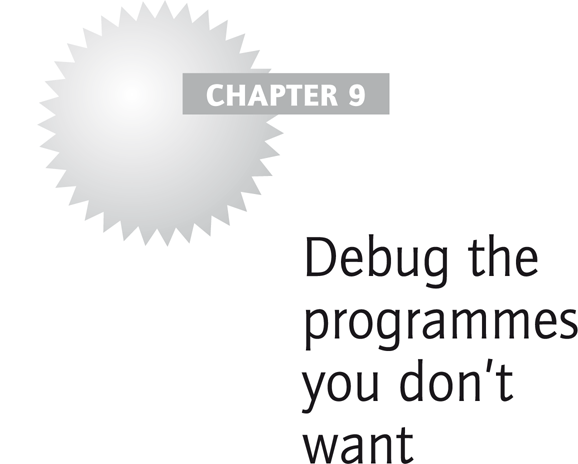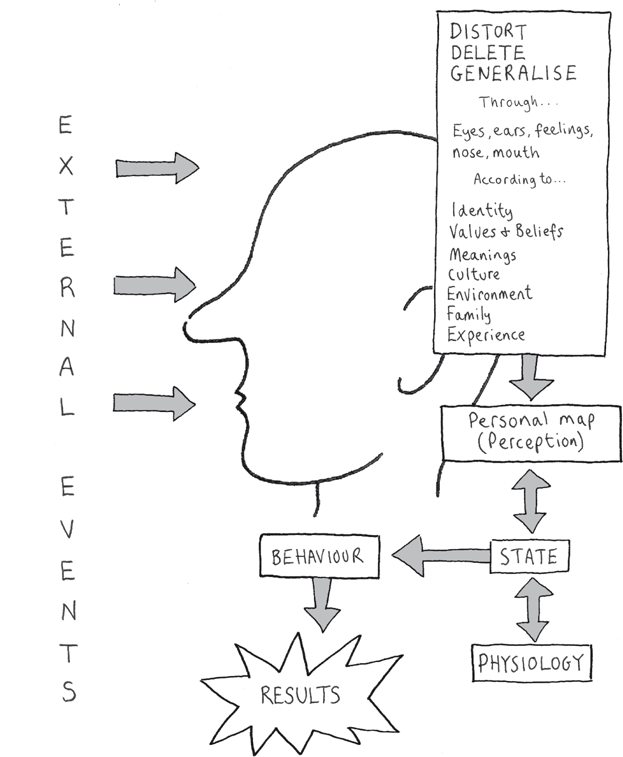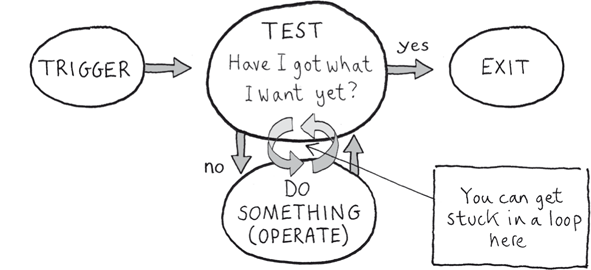
You have now covered all the main components that are involved in the way you communicate with yourself and others. The diagram on the next page shows how NLP puts it all together.
By generalising, deleting and distorting information, you create your own unique personal map of reality that you represent in your mind with imagery and sounds (smell and taste may also feature).
The result of this ‘internal representation of reality’ is a range of feelings. You have probably said to yourself on certain occasions, ‘I’m not in the right state of mind for this job right now’. That state of mind is actually a mind–body state, as the feelings responsible for it are not just in the head, but throughout your body. The state is caused by your personal map of reality, so, if you tell yourself that so-and-so is making you stressed, a state will be created and you will begin to feel tense, which will show in your behaviour. Likewise, if you feel intimidated by someone, the state created will result in behaviour that affects your ability to respond effectively.
You will see from the diagram that your state also affects your physiology. So, if you feel threatened and in a state of fear, you will try to make your body smaller to avoid the situation. This is a natural reaction to any threat, whether it is a physical one or a direct challenge to your authority by a more senior person. Of course, some people might react the opposite way, facing the challenge head-on. How you react to this or any type of situation depends on how you are creating your personal map of reality.

You will also notice in the diagram that your physiology also affects your state. That is why doctors often recommend physical exercise, such as running, for patients exhibiting signs of depression. Getting energy moving around the body has a positive effect on your mental state. You can use this technique, too, to get out of a negative state and give yourself a lift. You can also use deep breathing to calm yourself down. NLP utilises all the ways in which the mind and body affect each other.
This mind–body interaction is exactly the same in whatever state you create for yourself – it begins with your personal map. So, checking all the different aspects of your personal map, and making changes to create more positive and useful states, such as confidence, calm, focus, excitement, enthusiasm, persistence and so on, is at the core of NLP. That is how your programmes are formed and how you change them.
You have programmes for everything you do – motivating yourself, procrastinating, negotiating, getting tired, buying things. You also have programmes for all the things you would rather not do but continue with because you have formed a strong habit of doing them. All the programmes consist of sequences of thoughts and behaviour that are triggered by certain stimuli. In NLP, each sequence is called a ‘strategy’ for achieving an outcome. If you have ever tried to break a habit and failed, then it is more than likely that you were unaware of either the trigger or the unconscious parts of the strategy. Once you know about all the components of a strategy, you can do any number of things, including:
Dennis was very careful with his money. When he made a decision to buy something, he would follow a set strategy. It went something like this:
Compare this with Beverley’s strategy:
Some people who are good at spelling use a strategy consisting of visual pictures of the letters placed in the correct order, usually brightly coloured. A common reason for some people not being good spellers is that they don’t use such a good strategy. Poor spellers often try to spell by pronouncing words using their internal dialogue. Anyone can be a good speller – you just have to learn an effective strategy using visuals of words and not just what they sound like.
Whether it’s spelling, getting rich, finding a partner, buying something, learning a skill, getting a better job or being fitter and healthier, NLP gives you the models and techniques to be aware of what could be limiting you and the tools to change the situation.
One of the models for improving your success in all these areas and more is the TOTE model, which stands for:
This is the minimum number of steps involved in any process of decision making that begins with some kind of trigger causing you to make a decision. You will see from the model on the next page that there is a central point where people often get stuck in a loop.
You may have heard people quoting the following: ‘If you always do what you have always done you will always get what you have always got’, ‘Doing the same thing and expecting different results is a sign of madness’ or ‘If you want to change your results do something different’. Well, these quotes all relate to the TOTE model, which originates from G. A. Gallanter, E. Pribram and K. H. Miller who described it in their 1960 book Plans and the Structure of Behaviour (Holt, Reinhart and Winston). The model fits very well with the core principles of NLP and you can use it to become more aware of your own decision process.
Ineffective strategies prevent people from achieving so many things. How well do you manage your finances? What about the presentations you have given? How well do you communicate with people at work? Are you a good cook? What about the way you make decisions? Can you maintain positive and fruitful relationships?

Let’s take a typical ineffective behaviour as an example to see how the TOTE model works. How about intimidation? This usually means being in a situation where another person is acting in a way that causes you to feel inadequate and at loss for an effective response. So you decide that you are not going to be intimidated any more and think through what you are going to say the next time you meet the intimidating person. Next time comes and you blurt out what you have rehearsed (your Operation), but the other person comes back with an even stronger response and you crawl back into your shell. You might repeat this strategy any number of times, each time thinking of what else you can say: you are stuck in the TOTE loop.
To Exit the loop, you need to do something different. You need to develop a much stronger feeling of self-confidence, such that, no matter what anyone says, you will remain unaffected by it. You may also need a more effective system of language that doesn’t depend on remembering to say one rehearsed thing. The NLP metamodel described in Chapter 7 is ideal for this purpose.
There is another saying that you may also have heard: ‘You don’t know what you don’t know’. It refers to the fact that many people struggle with everyday situations in life and work, stuck in TOTE loops because they don’t know that there are skills that can help them to make an Exit. Many people struggle to give a formal presentation not knowing that a little NLP could make the experience highly rewarding and positive. Managers struggle to motivate their teams because they don’t know that there are skills they can learn to do this, and they can enjoy it. If you believe that good leaders are born and not made, your personal map will prevent you from exploring the possibility that effective leadership can be learned and enjoyed.
Whatever aspect of your life you want to improve, you can bet there is a strategy you are currently using that is holding you back, either creating inertia or producing undesirable results. The key is to know the beginning and end of each strategy so that you can change it.
When you elicit a strategy, you will discover values, beliefs and metaprogrammes, plus a sequence of thoughts, behaviour and physiological aspects, such as muscle tightness, posture, breathing rate, and so on.
Eliciting a strategy
Choose something you do that you would rather not do or something you would like to improve on – motivating yourself, stopping procrastinating, improving your decision making or giving up smoking, for example.
Find the trigger
Check the strategy
When you have elicited the complete strategy, repeat it back to check if anything is missing. If you want to change it, the place to do this is at the trigger point. The object is not to remove the original strategy but, rather, create an alternative choice, as the strategy may be useful in other contexts.
Norman wanted to stop smoking. He could manage without a cigarette most of the time, but found the urge irresistible when he had something to celebrate. At such times, his strategy included a visual of his hero on top of a mountain smoking a cigarette. This resulted in a strong belief that ‘all successful people smoke’, hence his need to smoke when he felt successful.
Once Norman realised that was his trigger, he changed his belief to ‘no matter how successful you are, smart people don’t smoke’. He was then able to modify his strategy at the trigger point, removing the cigarette from the visual of his hero. As a consequence, he lost the urge to smoke.

When you first work with strategies, there is a tendency to work with big chunks. The key to changing a strategy, though, can lie in a quick internal visual or in exaggerating or removing internal dialogue. Keeping to small chunks will allow you to access the essential finer details. Also, pay attention to the trigger point for a strategy – accessing the trigger point is vital to changing any strategy.

In this chapter you have learned that: